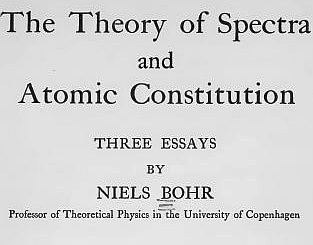What do you think?
Rate this book


136 pages, ebook
First published May 1, 1922
by Valentin Chirosca
As regards further information the reader in the case of the second essay is referred to a larger treatise "On the quantum theory of line spectra," two parts of which have appeared in the Transactions of the Copenhagen Academy (D. Kgl. Danske Vidensk. Selsk. Skrifter, 8. Rsekke, IV. 1, 1 and II, 191 8), where full references to the literature may be found.
The proposed continuation of this treatise, mentioned at several places in the second essay, has for various reasons been delayed, but in the near future the work will be completed by the publication of a third part. It is my intention to deal more fully with the problems discussed in the third essay by a larger systematic account of the application of the quantum theory to atomic problems, which is under preparation.
As mentioned both in the beginning and at the end of the third essay, the considerations which it contains are clearly still incomplete in character. This holds not only as regards the elaboration of details, but also as regards the development of the theoretical ideas. It may be useful once more to emphasize, that—although the word "explanation" has been used more liberally than for instance in the first essay—we are not concerned with a description of the phenomena, based on a well-defined physical picture. It may rather be said that hitherto every progress in the problem of atomic structure has tended to emphasize the well-known "mysteries" of the quantum theory more and more.
Niels Bohr was President of the Royal Danish Academy of Sciences, of the Danish Cancer Committee, and Chairman of the Danish Atomic Energy Commission. He was a Foreign Member of the Royal Society (London), the Royal Institution, and Academies in Amsterdam, Berlin, Bologna, Boston, Göttingen, Helsingfors, Budapest, München, Oslo, Paris, Rome, Stockholm, Uppsala, Vienna, Washington, Harlem, Moscow, Trondhjem, Halle, Dublin, Liege, and Cracow. He was Doctor, honoris causa, of the following universities, colleges, and institutes: (1923-1939) - Cambridge, Liverpool, Manchester, Oxford, Copenhagen, Edinburgh, Kiel, Providence, California, Oslo, Birmingham, London; (1945-1962) - Sorbonne (Paris), Princeton, Mc. Gill (Montreal), Glasgow, Aberdeen, Athens, Lund, New York, Basel, Aarhus, Macalester (St. Paul), Minnesota, Roosevelt (Chicago, Ill.), Zagreb, Technion (Haifa), Bombay, Calcutta, Warsaw, Brussels, Harvard, Cambridge (Mass.), and Rockefeller (New York).
Professor Bohr was married, in 1912, to Margrethe Nørlund, who was for him an ideal companion. They had six sons, of whom they lost two; the other four have made distinguished careers in various professions - Hans Henrik (M.D.), Erik (chemical engineer), Aage (Ph.D., theoretical physicist, following his father as Director of the Institute for Theoretical Physics), Ernest (lawyer).
From Nobel Lectures, Physics 1922-1941, Elsevier Publishing Company, Amsterdam, 1965